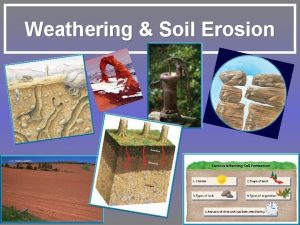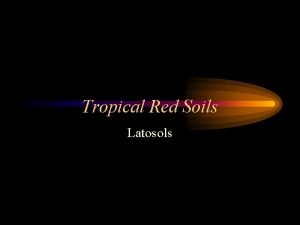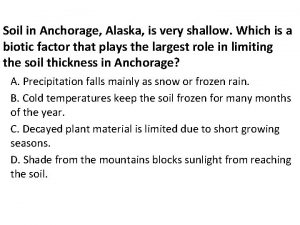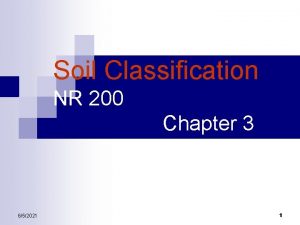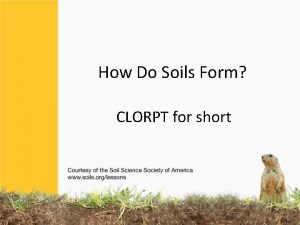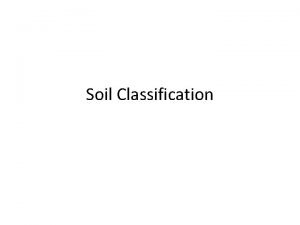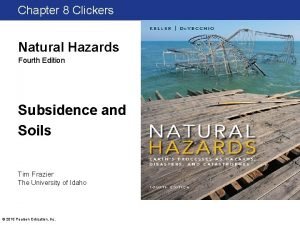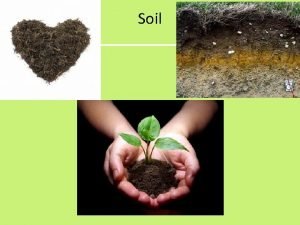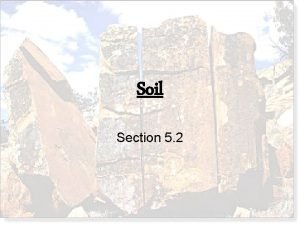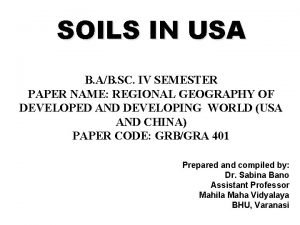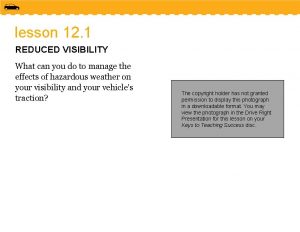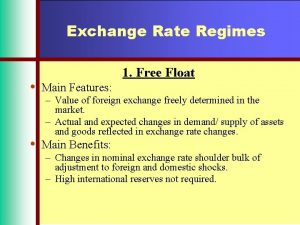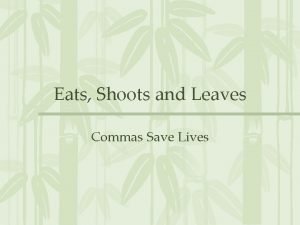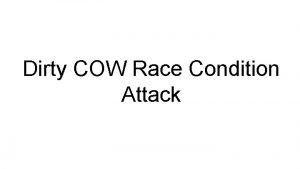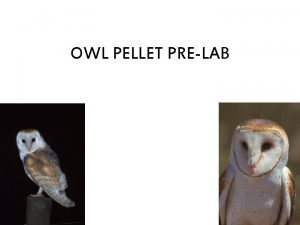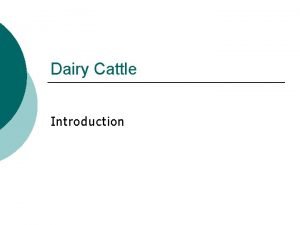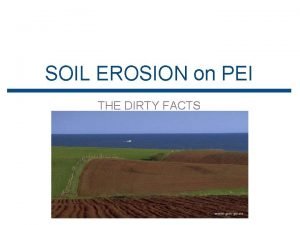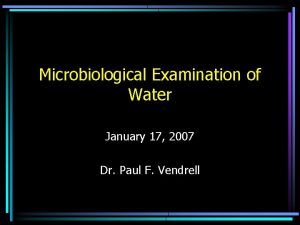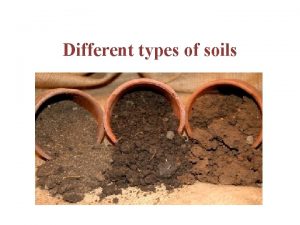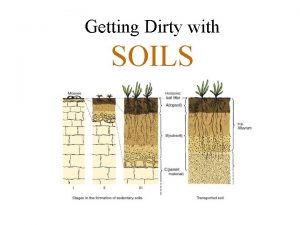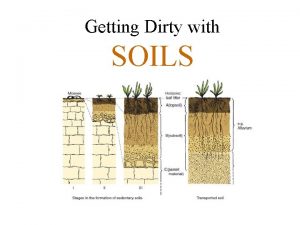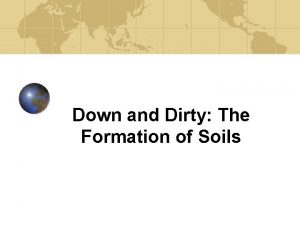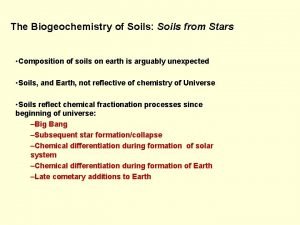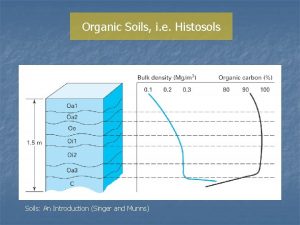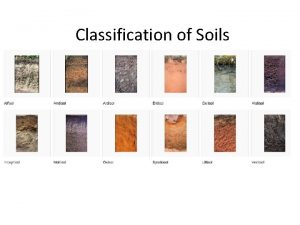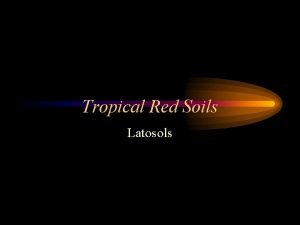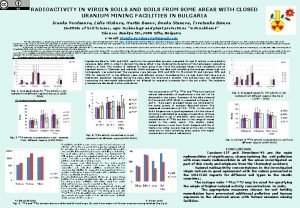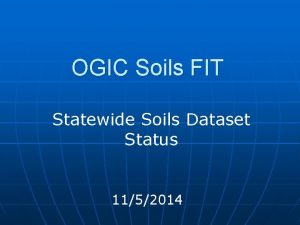Getting Dirty with SOILS Why Care Why Care


































































- Slides: 66

Getting Dirty with SOILS

Why Care?

Why Care?

I. Soil Profile the horizons…… O A B C R

R




E


Diagnostic properties (B horizon) • Texture • Structure • Color

Texture

• Structure

Diagnostic properties (B horizon) • Texture • Structure • Color

Munsell Color Chart


R

Soils II. Major Factors Controlling Soil Formation (from Jenny, 1951)

Soils II. Major Factors Controlling Soil Formation (from Jenny, 1951) A. Climate

Soils II. Major Factors Controlling Soil Formation (from Jenny, 1951) A. Climate B. Biota

A. Climate B. Biota

Soils II. Major Factors Controlling Soil Formation (from Jenny, 1951) A. Climate B. Biota C. Parent material

II. Major Factors Controlling Soil Formation (from Jenny, 1951) A. Climate B. Biota C. Parent material 1. Residual soils vs. Transported soils

C. Parent material 1. Residual soils vs. Transported soils

C. Parent material 1. Residual soils vs. Transported soils

Soils II. Major Factors Controlling Soil Formation (from Jenny, 1951) A. Climate B. Biota C. Parent material D. Slope

D. Slope

Soils II. Major Factors Controlling Soil Formation (from Jenny, 1951) A. Climate B. Biota C. Parent material D. Slope E. Time

E. Time

III. Major Soil Types

III. Major Soil Types A. Method: non genetic, based solely on physical properties

III. Major Soil Types A. Method: non genetic, based solely on physical properties

III. Major Soil Types A. Method: non genetic, based solely on physical properties B. Soil Types (Orders) there are 12 total…. . we will examine some of these.

Soil Orders Inceptisols Mollisols Ultisols Oxisols Aridisols Vertisols

Inceptisol Found on steep hillslopes and floodplains

Ultisols Common in forested areas

Oxisol Common in the tropics

Mollisol Common in prairie environments

Vertisol

Aridisols

Engineering Classification of Soils


I. Overview A. Two Systems of Classification 1. Pedological Classifications (soil weathering, texture, chemistry, profile thickness, etc. ) 2. Engineering Classifications – – soil texture degree of plasticity (Atterberg Limits)


B. Overview of Mechanics As water content increases, the shear strength decreases

It’s all about shear strength

C. Liquid Limit • Soil is practically a liquid • Shows minimal shear strength • Defined as the moisture content required to close a distance of 0. 5 inch along the bottom of a groove after 25 blows of the liquid limit device. animation

C. Liquid Limit D. Plastic Limit • Water content at which the soil is a plastic • Less water content than liquid limit • Wide range of shear strengths at plastic limit • Defined as the moisture content % at which the soil begins to crumble when rolled into 1/8” diameter threads animation

C. Liquid Limit D. Plastic Limit E. Plasticity Index (PI) • Difference between Liquid Limit and Plastic Limit • Important measure of plastic behavior

C. Liquid Limit In general…. D. Plastic Limit PI Degree of Plasticity 0 Nonplastic 1 -5 Slightly plastic 5 -10 Low plasticity 10 -20 Medium plasticity 20 -40 High plasticity 40+ Very high plasticity (from Burmister, 1949) E. Plasticity Index (PI) • Difference between Liquid Limit and Plastic Limit • Important measure of plastic behavior

I. Unified System A. Overview A. Arthur Casagrande (USAF) proposed for the construction of Airfields B. Basis -Over half of material retained on #200 sieve, use textural characteristics (gravel and sand) -Over half of material passes the #200 sieve, use plasticity-compressibility characteristics (silt & clay)

II. Unified System B. The classification scheme

II. Unified System C. The procedure 1. Determine the percent passing through the #200 sieve (boundary between sand silt/clay). 1. 2. If less than 50% passes, then it is a coarse grained soil (gravel and sand) If greater than 50% passes, then it is a fine grained soil (silt and clay)

“clayey materials” “silty materials”


Uniformity Coefficient = D 60/D 10, where we use the % finer by weight (% passing through) for the values



“clayey materials” “silty materials”


“It’s all about the permeability of your soil. ”

D. Field Methods for Determining Permeability In one locality: “Perk rates that are less than 15 minutes per inch or greater than 105 minutes per inch are unacceptable measurements. “

D. Field Methods for Determining Permeability 1. Double Ring Infiltrometer

D. Field Methods for Determining Permeability 2. Johnson Permeameter


 The secret to getting ahead is getting started
The secret to getting ahead is getting started Soils in ____ contain little organic material and are thin.
Soils in ____ contain little organic material and are thin. Red latosol
Red latosol Soil
Soil Soil anchorage
Soil anchorage Aridisols are soils characteristically found in _______.
Aridisols are soils characteristically found in _______. Timbering in dry loose soils
Timbering in dry loose soils How do soils form
How do soils form What is soil
What is soil How does the study of soils help evaluate natural hazards?
How does the study of soils help evaluate natural hazards? 4 components of soil
4 components of soil Which is not true of laterite soils
Which is not true of laterite soils Porosity of soil
Porosity of soil Forensics
Forensics Pedalfers
Pedalfers Why why why why
Why why why why Which of the following does not describe lennie
Which of the following does not describe lennie Why is candy unable to imagine getting rid of his old dog?
Why is candy unable to imagine getting rid of his old dog? Primary secondary tertiary care definition
Primary secondary tertiary care definition Dirty mind test
Dirty mind test Andrew gonce
Andrew gonce Dirty headlights can reduce visibility up to
Dirty headlights can reduce visibility up to Dirty duncan placenta
Dirty duncan placenta Dirty duncan and shiny schultz
Dirty duncan and shiny schultz Siamese appliance
Siamese appliance Float main
Float main Dirty float exchange rate
Dirty float exchange rate Save the comma
Save the comma Dirty cow attack
Dirty cow attack Mrs.pratchett
Mrs.pratchett Site:slidetodoc.com
Site:slidetodoc.com Terry loves his wife and so do i.
Terry loves his wife and so do i. Youtube dirty jobs owl pellets
Youtube dirty jobs owl pellets Ascenex
Ascenex Msha dirty dozen
Msha dirty dozen Cranial nerve function mnemonic
Cranial nerve function mnemonic Dirty dozen human factors nederlands
Dirty dozen human factors nederlands Dirty jobs dairy cow midwife worksheet answers
Dirty jobs dairy cow midwife worksheet answers A small canadian thin lady
A small canadian thin lady Dirty air
Dirty air Soil loss estimation
Soil loss estimation Dirty router cam
Dirty router cam Our classroom is dirty
Our classroom is dirty Dirty rouleze
Dirty rouleze Decide evaluation framework
Decide evaluation framework Twinkle twinkle little star piani
Twinkle twinkle little star piani A cotton dirty old tie
A cotton dirty old tie Capacity planning predictive analytics
Capacity planning predictive analytics Argentina dirty war timeline
Argentina dirty war timeline Xylitol products
Xylitol products Dirty birds
Dirty birds Gnu dirty pillow 2014
Gnu dirty pillow 2014 Dirty float
Dirty float Talk dirty
Talk dirty Dirty float
Dirty float Discipline is not a dirty word
Discipline is not a dirty word Dirty poem about milking a cow
Dirty poem about milking a cow Dirty hippy fly
Dirty hippy fly Sandy feels dirty unless she bathes and changes
Sandy feels dirty unless she bathes and changes People who talk about appearance are
People who talk about appearance are Don't ask why why why
Don't ask why why why Andalusian chicken incomplete dominance
Andalusian chicken incomplete dominance Getting acquainted with the vehicle
Getting acquainted with the vehicle Altering a drivers license may result in
Altering a drivers license may result in The fur coat short story
The fur coat short story It's a frog eat frog world frog scienstructable
It's a frog eat frog world frog scienstructable Is uv getting stronger
Is uv getting stronger

